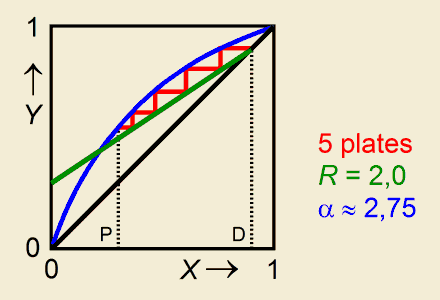Distillation at a given distillate compositionThe boiling liquid is a mixture of two volatile components, wherein the mole fraction of the more volatile component is symbolized by X (hence 1–X matches the less volatile component).
|
Program Listing |
Elucidation and Help |
| PROGRAM:RECTIBP | Title |
| ClrHome | > PRGM > I/O > ClrHome |
| Disp "REL.VOLATILITY" | (α>1) |
| Input A | |
| max(A,1)→A | > MATH > NUM > max( "→" Symbolizes the STO> key |
| Disp "X DISTILLATE" | Composition of the distillate. X is the mole fraction of the more volatile component of the liquid (0<X<1). |
| Input D | |
| min(D,1)→D | > MATH > NUM > min( |
| Disp "X POT MIXTURE" | Composition of the boiling mixture. X is the mole fraction of the more volatile component (0<X<1). |
| Input M | |
| min(M,D)→M | |
| Disp "REFLUX RATIO" | |
| Input R | |
| 0→Z:ClrHome | |
| Lbl 1 | > PRGM > CTL > Lbl |
| 0→N:D→X | |
| While X>M | |
| (RX+D)/(R+1)→Y | Y is the mole fraction of the more volatile component in the vapour phase (0<Y<1). |
| Y/(Y+A(1–Y))→X | Y and X are at equilibrium |
| N+1→N | |
| If Z=0 | |
| Goto 2 | |
| N→[B](N,1) | > 2nd, MATRX > NAMES > [B] |
| X→[B](N,2) | |
| Y→[B](N,3) | |
| Lbl 2 | |
| End | |
| If Z=1 | |
| Goto 3 | |
| Disp "NUMBER OF PLATES",N | |
| {N,3}→dim([B]) | > 2nd, MATRX > MATH > dim( |
| 1→Z | |
| Goto 1 | |
| Lbl 3 | |
| Disp "","PLATE, X, Y >>" | |
| Pause | |
| round([B],2)→[B] | |
| Disp [B] | Compositions (first seven plates) |
| Pause :ClrHome | |
| Disp "X,Y IN MAT [B]" | Merely a reminder |
After running and quitting the program, you still can have access to the liquid and vapour compositions X and Y of all plates. This may especially be of intrest when the number of plates exceeds seven. You'll find them stored in matrix [B] (> 2nd, MATRX > NAMES > [B], ENTER, ENTER).
ExampleConsider a mixture of benzene and toluene. Input values: Output: The vapour with composition Y3 = 0,87 is ascending from plate 3. (To retrieve the plate compositions as shown in an example coming with the program RECTIBD, put in XD = 0,972.) |
Hein ten Horn
Top | Programs Texas Instruments | Home
